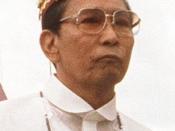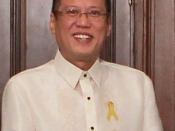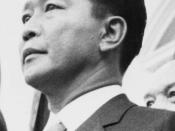October 10, 2001 Word Count: 2466 Research Question: How did Ferdinand E. Marcos eventually fall from power? INTRODUCTION Ferdinand E. Marcos was the longest reigning Philippine president in history. His rule spanned 20 years, beginning in 1965 up to his downfall in 1983. He was the first and only president re-elected so far (first in 1969 and second in 1981). After his second term, corruption in his administration was rampant. For 20 years he ruled the Philippines with an iron fist, and amassed a personal fortune. According to all sources, he managed to prolong his term for so long through his "private military"ÃÂ (Sonia M. Zaide, 217) that crushed or silenced opposition against him. His attempts to prolong his term however, were also responsible for the dissatisfaction of his people and the growth in opposition and against him which eventually led to his downfall, after the assassination of Benigno Aquino on 1983.
BACKGROUND ON MARCOS' RISE TO POWER Marcos came from a rich and politically prominent family in Ilocos, a province in the northern part of the Philippines. He began his political career in 1949, being elected to the House of Representatives as congressman of Ilocos. In 1965, he was elected as President of the Senate. He then (as a Nacionalista, one of the 2 main political parties) ran for president and gained victory over the incumbent president, Diosdado Macapagal. Marcos promised to "make the nation great again,"ÃÂ and during his first term of 6 years Marcos gained widespread popularity through his extensive economic and political achievements. In 1969 Marcos became the first (and up to the moment, still the only) re-elected president of the Philippines. During his second term however, Marcos lost popularity due to the extensive graft and corruption of his favoured cronies, and the human rights violations...


